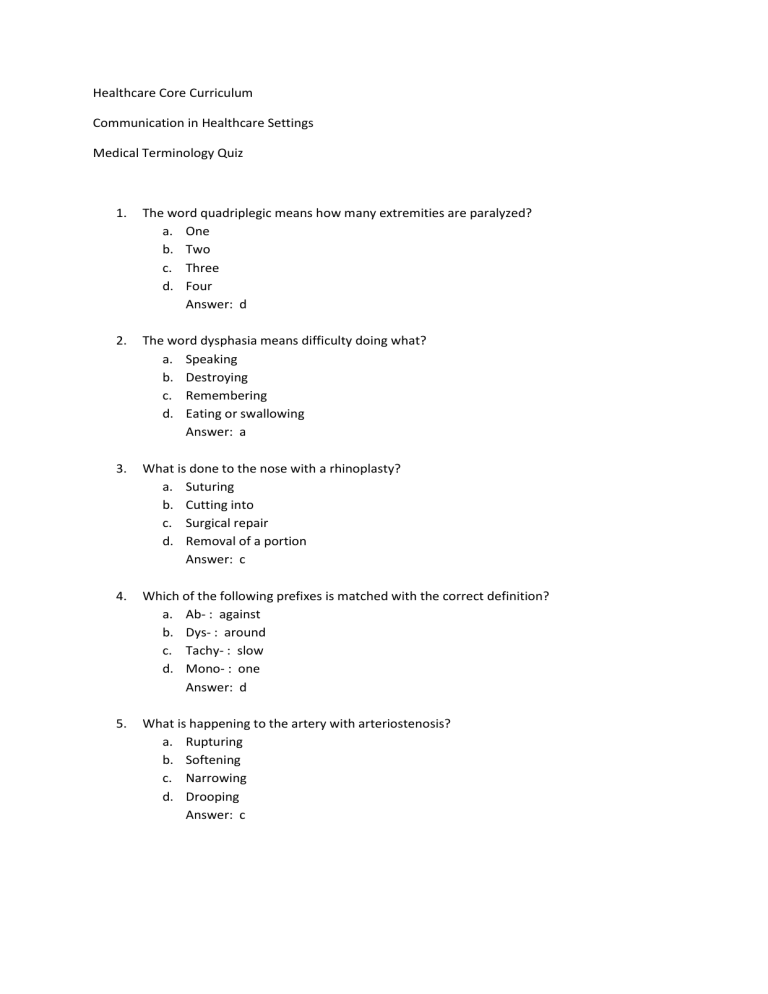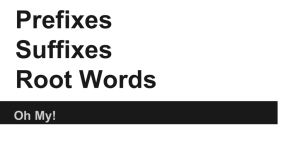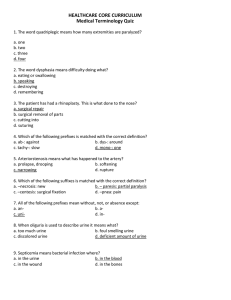Healthcare Core Curriculum Communication in Healthcare Settings

Healthcare Core Curriculum
Communication in Healthcare Settings
Medical Terminology Quiz
1.
The word quadriplegic means how many extremities are paralyzed? a.
One b.
Two c.
Three d.
Four
Answer: d
2.
The word dysphasia means difficulty doing what? a.
Speaking b.
Destroying c.
Remembering d.
Eating or swallowing
Answer: a
3.
What is done to the nose with a rhinoplasty? a.
Suturing b.
Cutting into c.
Surgical repair d.
Removal of a portion
Answer: c
4.
Which of the following prefixes is matched with the correct definition? a.
Ab- : against b.
Dys- : around c.
Tachy- : slow d.
Mono- : one
Answer: d
5.
What is happening to the artery with arteriostenosis? a.
Rupturing b.
Softening c.
Narrowing d.
Drooping
Answer: c
6.
Which of the following suffixes is matched with the correct definition? a.
–pnea: pain b.
–necrosis: new c.
–paresis: partial paralysis d.
–centesis: surgical fixation
Answer: c
7.
Which of the following prefixes means without, not, or absence? a.
An- b.
Uni- c.
Exo- d.
Multi-
Answer: a
8.
What does oliguria mean? a.
Too much urine b.
Discoloured urine c.
Foul smelling urine d.
Deficient amount of urine
Answer: d
9.
Septicemia means there is a bacterial infection in the: a.
Urine b.
Blood c.
Bones d.
Wound
Answer: b
10.
A client with dyspnea has which type of respirations? a.
Rapid b.
Painful c.
Normal d.
Congested
Answer: b
11.
Which abbreviation means “as needed”? a.
PRN b.
NPO c.
STAT d.
ROM
Answer: a
12.
Which position is a client in when they are laying on their back with their face looking up? a.
Prone b.
Supine c.
Anterior d.
Inferior
Answer: b
13.
Which term best describes moving away from the body? a.
Distal b.
Proximal c.
Abduction d.
Adduction
Answer: c
14.
A client with hypotension has what type of blood pressure reading? a.
Below normal b.
Above normal c.
Difficult to hear d.
Very loud to hear
Answer: a
15.
Polydipsia means excessive: a.
Pain b.
Thirst c.
Hunger d.
Urination
Answer: b
16.
What does the prefix tri- mean? a.
One b.
Two c.
Three d.
Four
Answer: c
17.
Nephrologist means _____________________ of the kidneys? a.
the study b.
the measurement c.
decreased function d.
specialist in the study
Answer: d
18.
What does the abbreviation NKA mean? a.
New knee amputation b.
No known allergies
c.
Need to know abbreviations d.
No known amputations
Answer: b
19.
What does the suffix –scopy mean? a.
Removing b.
Cutting into c.
Surgical repair d.
Visual examination
Answer: d
20.
Hematemesis means there is blood in the: a.
Urine b.
Vomit c.
Sputum d.
Stool/feces
Answer: b
21.
If a client has osteomalacia, what is happening? Their bones are: a.
Dying b.
Twisting c.
Softening d.
Hardening
Answer: c
22.
Which of the following suffixes means drooping? a.
–tripsy b.
–ptosis c.
–rrhagia d.
–rrhaphia
Answer: b
23.
Which term means toward the side? a.
Lateral b.
Dorsal c.
Anterior d.
Superior
Answer: a
24.
If a client has microcytic anemia, their red blood cells are too: a.
Few b.
Small c.
Large d.
Sticky
Answer: b
25.
In the term agoraphobia, what does the suffix mean? a.
Fear b.
Destroy c.
Rupture d.
Treatment
Answer: a
26.
With a gastropexy, what is being done to the stomach? a.
Surgical fixation b.
Surgical removal c.
Mechanical dilation d.
Internal examination
Answer: a
27.
Which term means slow movement? a.
Tachygenesis b.
Tachyphasia c.
Bradycardia d.
Bradykinesis
Answer: d
28.
Preoperative instructions are given _________________ the surgery. a.
After b.
During c.
Before d.
Within
Answer: c
29.
Where is extracellular fluid located? a.
Inside the cells b.
Within the cells c.
Between the cells d.
Outside of the cells
Answer: d
30.
If a client has pancreatitis, what is wrong with the pancreas? The pancreas is: a.
Small b.
Absent c.
Inflamed d.
In the wrong position
Answer: c






